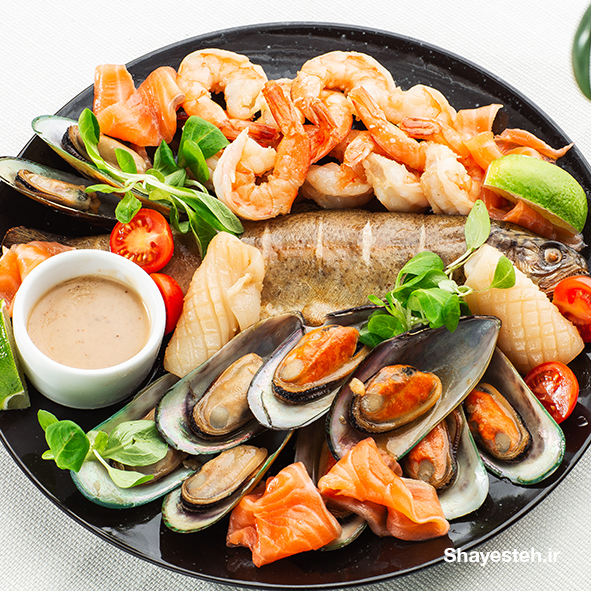در صورتی که اشکالی در ترجمه می بینید می توانید از طریق شماره زیر در واتساپ نظرات خود را برای ما بفرستید
09331464034
Topic:
A recent sales study indicates that consumption of seafood dishes in Bay City restaurants has increased by 30 percent during the past five years. Yet there are no currently operating city restaurants whose specialty is seafood. Moreover, the majority of families in Bay City are two-income families, and a nationwide study has shown that such families eat significantly fewer home-cooked meals than they did a decade ago but at the same time express more concern about healthful eating. Therefore, the new Captain Seafood restaurant that specializes in seafood should be quite popular and profitable.
Write a response in which you discuss what questions would need to be addressed in order to decide whether the conclusion and the argument on which it is based are reasonable. Be sure to explain how the answers to the questions would help to evaluate the conclusion.
یک مطالعه فروش اخیر نشان داده است که مصرف غذاهای دریایی در رستوران های Bay City طی پنج سال گذشته 30 درصد افزایش یافته است. در حال حاضر هیچ رستوران شهری فعال نیست که غذای دریایی از ویژگی های آن باشد. علاوه بر این، اکثریت خانواده ها در شهر خلیج خانواده هایی با دو درآمد هستند و یک مطالعه در سراسر کشور نشان داده است که چنین خانواده هایی نسبت به یک دهه قبل وعده های غذایی خانگی کمتری می خورند اما در عین حال نگرانی بیشتری در مورد تغذیه سالم دارند. بنابراین، رستوران جدید Captain Seafood که متخصص غذاهای دریایی است، باید کاملاً محبوب و سودآور باشد.
پاسخی بنویسید که در آن درباره اینکه چه سوالاتی باید پاسخ داده شود تا تصمیم بگیرید که آیا پیش بینی و استدلالی که بر آن استوار است منطقی است یا نه بحث کنید. حتماً توضیح دهید که چگونه پاسخ این سوالات به ارزیابی پیش بینی کمک می کند.
NOTE: The above topic has wording similar to Argument Task 37 of this Website. However, if you read carefully you will notice that the task instructions are different. Hence, it is very important to read the topic as well as its instructions completely before you start to write your response.
Strategies
A good place to start your analysis is by creating a statement that reveals the main idea of the argument. Although the writer is creating an argument, he may ultimately be stating a position, making a recommendation, or making a prediction. It may be helpful for you to determine which of these formats is most evident in the argument.
The author predicts that a new Captain Seafood restaurant in Bay City should be very profitable based on an apparent increase in the consumption of seafood dishes at local restaurants.
Assumptions:
a) Seafood dishes are healthier than other types of entrees.
b) A seafood restaurant will be successful in Bay City.
c) All restaurants in Bay City have seen a 30 percent increase in the sales of seafood dishes.
d) A 30 percent increase in the consumption of seafood dishes is significant.
e) Restaurants in Bay City are selling fewer meat and poultry entrees.
Questions:
a) Have seafood restaurants opened and closed in Bay City?
b) Do seafood dishes generate as much profit as meat and poultry dishes?
c) Is a 30 percent increase in the consumption of seafood dishes significant?
d) What percentage of total sales is represented by seafood dishes?
e) Are seafood dishes inherently healthier than other meat dishes?
After completing these steps, you should have enough material to write your analysis. Remember that you are not creating a position of your own; you are evaluating the strengths and weaknesses of the existing argument. You do not have to include all of the points that you have created in your prewriting. In fact, during the process of drafting your analysis, other ideas may come to mind, and, if they strengthen your analysis, you should include them.
NOTE: The above topic has wording similar to Argument Task 37 of this Website. However, if you read carefully you will notice that the task instructions are different. Hence, it is very important to read the topic as well as its instructions completely before you start to write your response.
Sample 1:
Anyone relying on the conclusion in this argument should first seek answers to several questions before conceding that the new Captain Seafood restaurant will be successful in Bay City. Any restaurateur needs more details about the facts offered in this scant list of reasons that support the promise of profitability in serving seafood to the residents of the town.
The survey reveals that consumption of seafood dishes in Bay City restaurants has increased by 30 percent during the past five years. The percentage is significant, but how does that translate into dollars? For example, suppose that sales of seafood dishes five years ago totaled $500. A 30 percent increase would mean that the most recent sales total $650. On the other hand, sales of $50,000 five years ago would be $65,000 today. Determining the success of the new Captain Seafood eatery based on an increase in sales would depend on which answer is correct. The significance of the increase would also depend on how high or low the percentage of sales was in previous years. What was the percentage of sales represented by seafood dishes? If it were 5 percent, a 30 percent increase would mean that current sales are 6 1/2 percent, hardly enough to declare that Captain Seafood will be profitable. If previous sales accounted for 20 percent of total sales, today they are 26 percent of the total. Now, one in four orders is for seafood dishes, perhaps a significant number to make the author’s conclusion reasonable.
Does an increase in the sales of seafood dishes translate into higher profits? If, for example, the restaurant serves lobster, it must have a tank in which to keep those crustaceans alive. Some are likely to die anyway, and they must be discarded, and those sales are lost. Seafood tends to be more delicate in nature than beef, pork, or chicken and may require more labor-intensive handling and preparation which increases overhead. Pricing seafood dishes to make them as attractive as other entrees may have a negative effect on the bottom line.
Why are there no seafood restaurants currently operating in Bay City? The use of the word currently, itself, may give pause to anyone considering this enterprise in the city. If such restaurants existed in the past, one should seek to know why they closed. If they closed as a result of poor management, developing a strong business plan should, indeed, enable a restaurateur to presume success in a new venture. If, however, those restaurants closed because the citizens were not interested in seafood or could not afford the dishes, the start-up might not be a good idea. Relying on past restaurant's success rates may not be sufficient for making a decision. Have the demographics of Bay City changed significantly? The age and socioeconomic status of Bay City residents may have risen or declined. If the average age is lower and the median income higher, families may have more expendable income to spend on dining out and ordering what may be pricier seafood entrees. On the other hand, an elderly population with a lower median income creates more risk for the new Captain Seafood restaurant.
Are seafood dishes more suitable for a health-conscious diet than other types of dishes? Before using this rationale to predict success for a seafood restaurant in Bay City, one must also ask what method has been used to prepare the most popular dishes in the local restaurants. If battered, deep-fried fish and clams are the most frequently ordered main courses, the impetus to order them is unlikely to be reduced fat and calories. Conversely, if the most popular dishes are steamed or poached fish fillets, the question may be answered in the affirmative.
The answers to these questions should help to evaluate the author’s prediction of success for Captain Seafood in Bay City. Relying solely on the insufficient and, perhaps, anecdotal information in the argument might lead the reader to an erroneous conclusion about the likelihood of the new restaurant’s ability to thrive.
Sample 2:
The arguer has drawn the conclusion that establishing a new Bay City restaurant that specializes in seafood would be both profitable as well as popular. The argument relies on two facts as evidence in support of the claim made. The first is that the consumption of seafood dishes in Bay City restaurants have increased over the past five years, but there are no restaurants in Bay City that specialize in seafood. The second fact states that the majority of the families in Bay City are two-income families and the results of a nationwide survey have indicated that two-income families are increasingly concerned about healthy eating habits and they are eating fewer home-cooked meals. However, the facts presented by the arguer are insufficient to prove that a new Bay City restaurant specializing in seafood would be popular and profitable.
The fact that there are no seafood restaurants in Bay City, despite the increase in the consumption of seafood, does not necessarily mean that a restaurant specializing in seafood would be popular and profitable. Firstly, the increase in consumption by thirty percent is insignificant in view of the fact that this has happened over a period of five years. Moreover, if seafood was indeed so popular among the residents of Bay City, then restaurants specializing in seafood would have come up by now. Moreover, the restaurants that serve seafood dishes would have diversified into separate restaurants for serving seafood dishes only, if there was a huge demand for the same. The very fact that these restaurants are continuing to serve seafood dishes in addition to other dishes prove that these restaurants are not making much profit from the consumption of seafood.
Additionally, it is likely that the increase in consumption is not only for seafood, but also for the other dishes being served by popular restaurants. People may be going to these restaurants because they like their preparation or the ambience. It is highly unlikely that they will stop going to their favorite restaurants to dine at a new restaurant that serves only seafood. Therefore, the new restaurant will have to compete with the other restaurants that are already popular in Bay City and which offer other dishes in addition to seafood dishes. The new restaurant may not be able to make profit unless it is able to build up a sizeable clientage, which seems unlikely in view of the above mentioned aspects related to dining in Bay City restaurants.
The arguer fails to provide substantial evidence to prove the relevance of the nationwide survey in the context of the two-income families residing in Bay City. There is no mention of the percentage of Bay City families who were a part of this survey. It is likely that the survey included families residing in big cities and metros and the type of lifestyle that they follow permits them to eat out regularly. It is quite possible that the families in Bay City are not too keen on eating out as opposed to their counterparts in bigger cities. Moreover, if the families are health conscious, then they would not like to eat in a new restaurant as they would doubt the quality of food being served and they would rather eat at the restaurants where they have been dining in the past. Therefore, the arguer fails to provide a link between the nationwide survey and the dining habits of the two-income families of Bay City in order to substantiate his recommendation.
The argument could have been strengthened if both the surveys had provided information related to the willingness of the Bay City residents to eat seafood. Moreover, the profits earned by a restaurant depend on the initial investments along with the expenses incurred in the maintenance of the restaurant. The arguer does not provide information related to such data. Therefore, the argument fails to convince the reader that a new Bay City restaurant specializing in seafood will be profitable and popular.
نظرات کاربران
هنوز نظری درج نشده است!


